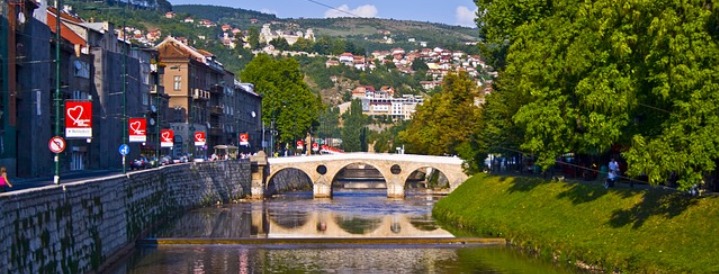Sarajevo, capital city of Bosnia and Herzegovina
As you explore Sarajevo, you may find yourself wondering how a people who have suffered so much created such a vibrant, vivacious city. The capital of Bosnia and Herzegovina came close to complete annihilation in the 1990s but has bounced backed to become a premier travel destination and one of the most interesting cities in Europe. A living history museum, Sarajevo is filled with churches, mosques, cathedrals and government buildings constructed by Austria-Hungarians and the Ottoman Turks. It also is filled with charm, from the bustling city center to the cozy bars and coffeehouses and artisans’ workshops. The village-like atmosphere quickly makes visitors feel comfortable, and many find themselves wanting to stay in Sarajevo much longer than they originally planned.
Old Town is the crowning glory of Sarajevo. Oriental-style shops line the cobbled streets, competing for space with some of the world’s most beautiful religious institutions. It is one of the few places in the world where you can hear the Islamic call to prayer while walking past an Orthodox church, a catholic cathedral or a synagogue at the same time. All four religions share one block of the neighborhood, exemplifying the diversity of the city.
Built in 1531, the Gazi Husrev Bey Mosque is particularly worth visiting. The superb internal decorations are a delight for the eyes, featuring colorful lines, patterns, and calligraphy in cotton-candy pastel shades that highlight every architectural feature.
A number of museums give visitors background for deeper exploration of Sarajevo’s past, people and culture. The best is the Bosnian Historical Museum, where a moving display on the city’s siege will haunt visitors long after they leave. Especially heartbreaking are the pictures were drawn by children who lived through the experience.
The Tunnel Museum paints a picture of the city’s hopes and horrors during the 1990s. During the siege, the tunnel was used to transport supplies into the city and to access the airport, but those trying to enter it were pummeled with sniper fire and overhead artillery while waiting to go through. Walking through space, you can almost feel the anxiety and urgency in the atmosphere even today.
In a city rich with so much history, it is hard to choose the most significant place, but the Latin Bridge is definitely a contender. In 1914, Archduke Franz Ferdinand of Austria crossed the bridge in an open car after stopping to admire the town hall. Gavrilo Princip pulled the trigger on his pistol, killing the archduke and his wife and sparking a war between Serbia and Austria-Hungary. Thanks to a web of alliances in Europe, this act led to the First World War.
The remnants of war are still visible throughout many parts of the capital. As you walk through the streets, look down at the sidewalk to spot red roses made of concrete. The flower-shaped indentations mark where shells exploded and are now icons of the war.
The hills that surround the capital offer incredible views of the city, but the fields, wooded areas, and grass are still riddled with landmines. Stay safe by sticking to the sidewalks as you hike, enjoy the views and discover some of the wooden mosques that have survived the war.
The Yellow Fortress also provides incredible views of the city from its place at the Old Town’s eastern end. The nearby cemetery is filled with locals killed during the war, providing a powerful reminder of the country’s past. These sights also show just how far Sarajevo has come since the war’s end.
Sarajevo Geographical Location
Sarajevo is located in the central southeast of Bosnia and Herzegovina along the Milijacka River. It is its largest city with a population of approximately 664,000.
Sarajevo Language
Bosnian and Croatian are the official languages of Bosnia and Herzegovina with Serbian also being common throughout the country.
Sarajevo Predominant Religion
- 40% Muslim
- 31% Orthodox
- 15% Roman Catholic
- 14% Other
There is religious freedom in Bosnia and Herzegovina according to their constitution but the observance by officials has declined in recent years.
Sarajevo Currency
The Bosnia and Herzegovina Convertible Mark is the official currency of Bosnia and Herzegovina.
Sarajevo Climate
Sarajevo experiences warm summers and cold winters. There are four distinct season and consistent precipitation throughout them all.
Sarajevo Main Attractions
- Sarajevo War Tunnel
- Old Town
- Vrelo Bosna
Other Attraction in Sarajevo
- Latin Bridge
- Morica Han
- National Library
- Sebilj
